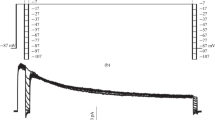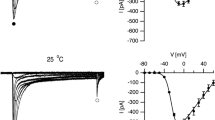Abstract
-
1.
The experiments were done on voltage-clamped nodes of Ranvier of the frog. The aim was to study the kinetics of sodium currentI Na and gating currentI gat over a large potential range (−92 to −12 mV) and to compare the time constants for the turning-on ofI Na orI gat with those for the turning-off measured at the same potential.
-
2.
Sodium tail currents were recorded at different postpulse potentials. Inactivation was inhibited by a few min treatment with 0.5 mM chloramine-T (Wang 1984). The sodium permeability was activated by a 0.4 ms pulse from holding potential (−92 mV) to about 0 mV. At the peak ofI Na the membrane was repolarized to postpulse potentials between −92 and −12 mV. AtE> −60 mV the tail currents decayed with two time constants, τ1 and τ2, reflecting presumably the turning-off and the inactivation of the sodium permeability. The relation between τ1 and postpulse potential was bellshaped with a maximum at −32 mV.
-
3.
The tail currents could also be fitted by the Hodgkin-Huxley equation with the sodium activation variablem raised to the second or third power. AtE<−50 mV τm off was equal to 2 τ1 or 3 τ1, respectively, whereas atE>−25 mV τm off was equal to τ1.
-
4.
In addition, the time constant of the turning-on of sodium activationm (τm on) was determined, assumingI Na ∼m 2 (with a small initial delay) orI Na ∼m 3 (without an initial delay). At −22 mV and −12 mV the ratio τm off/τm on was close to 1. At −42 mV and −32 mV it was larger than 1 (1.22 and 1.65 for them 2 andm 3 fit, respectively, at −32 mV).
-
5.
A similar pulse program was used to measure the turning-on and turning-off ofI gat in the presence of 300 nM TTX. In the potential range −52 to −22 mV, no significant difference between τoff and τon (measured at the same potential) was found. This is in conflict with the findings of Dubois and Schneider (1982) who reported an inequality τoff < τon.
-
6.
Comparison between τoff of charge movement and τ1 of the tail current yielded τoff/τ1 = 2.8 at −92 mV. This agrees with previous measurements of Neumcke et al. (1976).
Similar content being viewed by others
References
Attwell D, Bergman C, Ojeda C (1979) The action of salicylate ions on the frog node of Ranvier. J Physiol 295:69–81
Brown AM, Tsuda Y, Wilson DL (1983) A description of activation and conduction in calcium channels based on tail and turn-on current measurements in the snail. J Physiol 344:549–583
Byerly L, Hagiwara S (1982) Calcium currents in internally perfused nerve cell bodies ofLimnea stagnalis. J Physiol 322:503–528
Cahalan MD, Chandy KG, DeCoursey TE, Gupta S (1985) A voltage-gated potassium channel in human T lymphocytes. J Physiol 358:197–237
Chiu SY (1980) Asymmetry currents in the mammalian myelinated nerve. J Physiol 309:499–519
Dodge FA (1963) A study of ionic permeability changes underlying excitation in myelinated nerve fibres of the frog. Thesis, The Rockefeller University, University Microfilms Inc., Ann Arbor (no 64-7333)
Dubois JM, Schneider JF (1982) Kinetics of intramembrane charge movement and sodium current in frog node of Ranvier. J Gen Physiol 79:571–602
Frankenhaeuser B (1960) Quantitative description of sodium currents in myelinated nerve fibres ofXenopus laevis. J Physiol 151:491–501
Frankenhaeuser B (1963) Inactivation of the sodium-carrying mechanism in myelinated nerve fibres ofXenopus laevis. J Physiol 169:445–451
Frankenhaeuser B, Huxley AF (1964) The action potential in the myelinated nerve fibre ofXenopus laevis as computed on the basis of voltage clamp data. J Physiol 171:302–315
Goldman L, Hahin, R (1978) Initial conditions and the kinetics of the sodium conductance inMyxicola giant axons. II. Relaxation experiments. J Gen Physiol 72:879–898
Hille B (1968) Charges and potentials at the nerve surface. Divalent ions and pH. J Gen Physiol 51:221–236
Keynes RD, Kimura JE (1983) Kinetics of activation of the sodium conductance in the squid giant axon. J Physiol 336:621–634
Koppenhöfer E (1967) Die Wirkung von Tetraäthylammoniumchlorid auf die Membranströme Ranvierscher Schnürringe vonXenopus laevis. Pflügers Arch 293:34–55
Meves H, Rubly N (1985) Sodium tail currents at different postpulse potentials in the voltage-clamped frog node of Ranvier. J Physiol 369: 103P
Neumcke B, Nonner W, Stämpfli R (1976) Asymmetrical displacement current and its relation with the action of sodium current in the membrane of frog myelinated nerve. Pflügers Arch 363:193–203
Neumcke B, Nonner W, Stämpfli R (1978) Gating currents in excitable membranes. In: International Review of Biochemistry, vol 19. Metcalfe JC (ed) Biochemistry of cell walls and membranes II. University Park Press, Baltimore
Neumcke B, Stämpfli R (1984) Heterogeneity of external surface charges near sodium channels in the nodal membrane of frog nerve. Pflügers Arch 401:125–131
Nonner W (1969) A new voltage clamp method for Ranvier nodes. Pflügers Arch 309:176–192
Nonner W, Rojas E, Stämpfli R (1978) Asymmetrical displacement currents in the membrane of frog myelinated nerve: early time course and effects of membrane potential. Pflügers Arch 375:75–85
Oxford GS (1981) Some kinetic and steady-state properties of sodium channels after removal of inactivation. J Gen Physiol 77:1–22
Rack M, Rubly N, Waschow C (1986) Effect of some chemical reagents on sodium current inactivation in myelinated nerve fibers of the frog. Biophys J, submitted
Shauf CL, Bullock JO, Pencek TL (1977) Characteristics of sodium tail currents inMyxicola axons. Comparison with membrane asymmetry currents. Biophys J 19:7–28
Sigworth FJ (1980) The variance of sodium current fluctuations at the node of Ranvier. J Physiol 307:97–129
Wang GK (1984) Irreversible modification of sodium channel inactivation in toad myelinated nerve fibres by the oxidant chloramine-T. J Physiol 346:127–141
Author information
Authors and Affiliations
Rights and permissions
About this article
Cite this article
Meves, H., Rubly, N. Kinetics of sodium current and gating current in the frog node of Ranvier. Pflugers Arch. 407, 18–26 (1986). https://doi.org/10.1007/BF00580715
Received:
Accepted:
Issue Date:
DOI: https://doi.org/10.1007/BF00580715




